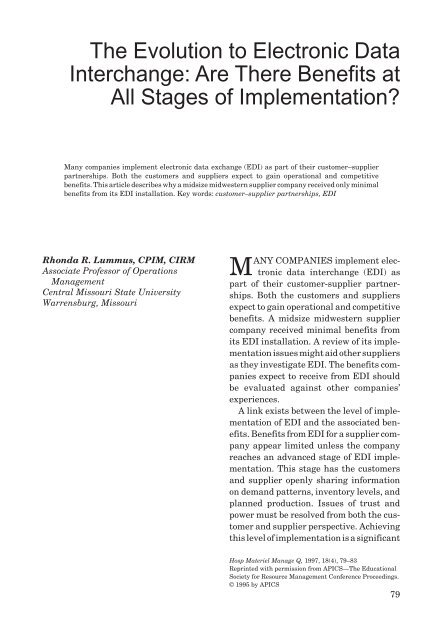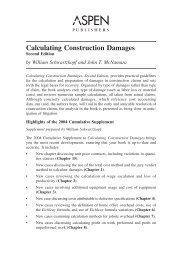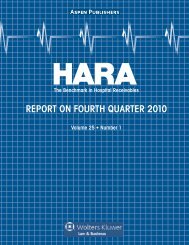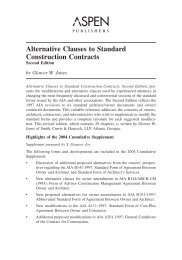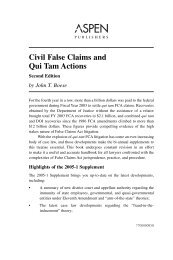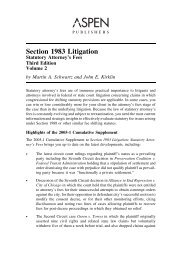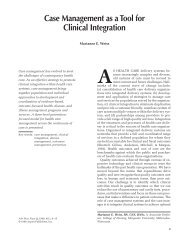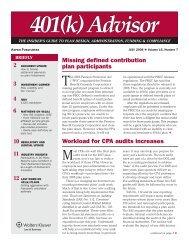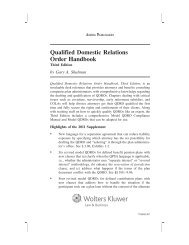The Evolution to Electronic Data Interchange ... - Aspen Publishers
The Evolution to Electronic Data Interchange ... - Aspen Publishers
The Evolution to Electronic Data Interchange ... - Aspen Publishers
You also want an ePaper? Increase the reach of your titles
YUMPU automatically turns print PDFs into web optimized ePapers that Google loves.
<strong>The</strong> <strong>Evolution</strong> <strong>to</strong> EDI 79<br />
<strong>The</strong> <strong>Evolution</strong> <strong>to</strong> <strong>Electronic</strong> <strong>Data</strong><br />
<strong>Interchange</strong>: Are <strong>The</strong>re Benefits at<br />
All Stages of Implementation<br />
Many companies implement electronic data exchange (EDI) as part of their cus<strong>to</strong>mer–supplier<br />
partnerships. Both the cus<strong>to</strong>mers and suppliers expect <strong>to</strong> gain operational and competitive<br />
benefits. This article describes why a midsize midwestern supplier company received only minimal<br />
benefits from its EDI installation. Key words: cus<strong>to</strong>mer–supplier partnerships, EDI<br />
Rhonda R. Lummus, CPIM, CIRM<br />
Associate Professor of Operations<br />
Management<br />
Central Missouri State University<br />
Warrensburg, Missouri<br />
M<br />
ANY COMPANIES implement electronic<br />
data interchange (EDI) as<br />
part of their cus<strong>to</strong>mer-supplier partnerships.<br />
Both the cus<strong>to</strong>mers and suppliers<br />
expect <strong>to</strong> gain operational and competitive<br />
benefits. A midsize midwestern supplier<br />
company received minimal benefits from<br />
its EDI installation. A review of its implementation<br />
issues might aid other suppliers<br />
as they investigate EDI. <strong>The</strong> benefits companies<br />
expect <strong>to</strong> receive from EDI should<br />
be evaluated against other companies’<br />
experiences.<br />
A link exists between the level of implementation<br />
of EDI and the associated benefits.<br />
Benefits from EDI for a supplier company<br />
appear limited unless the company<br />
reaches an advanced stage of EDI implementation.<br />
This stage has the cus<strong>to</strong>mers<br />
and supplier openly sharing information<br />
on demand patterns, inven<strong>to</strong>ry levels, and<br />
planned production. Issues of trust and<br />
power must be resolved from both the cus<strong>to</strong>mer<br />
and supplier perspective. Achieving<br />
this level of implementation is a significant<br />
Hosp Materiel Manage Q, 1997, 18(4), 79–83<br />
Reprinted with permission from APICS—<strong>The</strong> Educational<br />
Society for Resource Management Conference Proceedings.<br />
© 1995 by APICS<br />
79
80 HOSPITAL MATERIEL MANAGEMENT QUARTERLY/MAY 1997<br />
challenge for those manufacturing professionals<br />
involved in EDI installations!<br />
IMPLEMENTING EDI AT A<br />
SUPPLIER COMPANY<br />
ABC is a midsize midwestern manufacturing<br />
company with approximately 800<br />
employees. ABC produces cast metal products<br />
for much larger “original equipment”<br />
manufacturers. It began EDI implementation<br />
by linking with a single large cus<strong>to</strong>mer.<br />
<strong>The</strong> large cus<strong>to</strong>mer “strongly suggested”<br />
ABC implement an EDI system if it<br />
wanted <strong>to</strong> continue <strong>to</strong> remain a supplier.<br />
<strong>The</strong> transactions currently exchanged<br />
through EDI are the typical purchasing,<br />
transportation, and invoicing transactions<br />
between a buyer and seller. Purchase orders,<br />
inven<strong>to</strong>ry advice, material release,<br />
and shipping schedules are transmitted<br />
from the cus<strong>to</strong>mer; while advance shipping<br />
notices are sent from the supplier. A payon-receipt<br />
policy based on the advanced<br />
shipping notice has eliminated invoices.<br />
Transactions are batched through translation/mapping<br />
software and the use of a<br />
value-added network (VAN). ABC uses an<br />
IBM AS400 computer system and an integrated<br />
manufacturing and accounting planning<br />
system. Production requirements are<br />
received twice weekly from the cus<strong>to</strong>mer,<br />
and shipment notices are transmitted daily.<br />
<strong>The</strong> cus<strong>to</strong>mer continues <strong>to</strong> send a fax transmission<br />
of the exact quantities <strong>to</strong> load on<br />
specific trucks two days prior <strong>to</strong> the ship<br />
date.<br />
Few changes have occurred in ABC’s<br />
procedures. Requirement and purchase<br />
order information is printed through translation<br />
software and manually keyed in<strong>to</strong><br />
the company’s MRP system. A materiel<br />
coordina<strong>to</strong>r compares the requirement data<br />
<strong>to</strong> current schedules and enters any<br />
changes, exactly as is done for all other<br />
cus<strong>to</strong>mers.<br />
ABC is in various stages of implementation<br />
of EDI with three other cus<strong>to</strong>mers. One<br />
sends requirement information weekly<br />
through EDI but does not receive information<br />
from ABC. One receives information<br />
from ABC on shipments but does not send<br />
requirement information. <strong>The</strong> last company<br />
is studying the feasibility of implementing<br />
EDI. None of the cus<strong>to</strong>mers can inquire in<strong>to</strong><br />
ABC’s planning system <strong>to</strong> determine inven<strong>to</strong>ry<br />
status or other planning information,<br />
and ABC does not plan <strong>to</strong> implement that<br />
capability at this time. ABC has discussed<br />
using EDI with one supplier but has not<br />
actively pursued implementation.<br />
BENEFITS OF EDI FOR<br />
SUPPLIERS<br />
Large firms, buying from multiple suppliers<br />
with a high volume of transactions,<br />
receive substantial benefits with EDI, but<br />
ABC identified only a limited number of<br />
benefits it received. <strong>The</strong> information systems<br />
manager summarized the benefits as<br />
“improvements in the transaction process.”<br />
EDI reduced the number of transaction<br />
errors, reduced paperwork, improved the<br />
quality of transactions, and reduced the<br />
time needed <strong>to</strong> trace errors. Purchase order<br />
and requirement information is received<br />
the same day, improving the timeliness<br />
of the information. However, hard<br />
copies of purchase orders are created and<br />
manually keyed in<strong>to</strong> the MRP system.<br />
<strong>The</strong>se benefits have had a minimal impact
<strong>The</strong> <strong>Evolution</strong> <strong>to</strong> EDI 81<br />
on the firm’s operations due <strong>to</strong> the slow<br />
integration of other cus<strong>to</strong>mers.<br />
Other cus<strong>to</strong>mer service benefits are more<br />
difficult <strong>to</strong> quantify, but the managers believe<br />
they exist. <strong>The</strong> use of EDI gives the<br />
company a higher service rating in one<br />
cus<strong>to</strong>mer’s supplier rating program. <strong>The</strong><br />
exchange of information required during<br />
EDI installation and the ongoing changes<br />
required with the system have increased<br />
the personal contact between ABC and its<br />
cus<strong>to</strong>mers. Daily telephone calls and fax<br />
transmissions have been eliminated and<br />
replaced by more planning and strategic<br />
business discussions.<br />
PROBLEMS WITH EDI FOR<br />
SUPPLIERS<br />
ABC identified several problems with using<br />
EDI. One problem involves translating<br />
cus<strong>to</strong>mer files directly in<strong>to</strong> the MRP system.<br />
System changes are necessary <strong>to</strong> receive<br />
cus<strong>to</strong>mer information directly in<strong>to</strong> the system.<br />
<strong>The</strong> changes must include a process for<br />
evaluating cus<strong>to</strong>mer information since human<br />
intervention is often required <strong>to</strong> determine<br />
the feasibility of meeting demand.<br />
A second problem stems from installing<br />
EDI connections with multiple cus<strong>to</strong>mers.<br />
Each cus<strong>to</strong>mer may have different requirements,<br />
possibly including individual file<br />
development. Required changes are as specific<br />
as the characteristics of certain fields.<br />
<strong>The</strong> company is currently working with its<br />
MRP software supplier <strong>to</strong> resolve the system<br />
problems. <strong>The</strong> connection of multiple<br />
VANs has also presented some difficulties<br />
and added cost.<br />
<strong>The</strong> number of staff positions has not<br />
decreased at ABC as a result of EDI. In fact,<br />
staff responsibilities have increased because<br />
of the required changes in the company’s<br />
information system and the continued<br />
manual input of some EDI transactions.<br />
LINKING BENEFITS WITH<br />
IMPLEMENTATION LEVEL<br />
<strong>The</strong> study of one EDI implementation<br />
could lead <strong>to</strong> the conclusion that EDI has<br />
few benefits for small manufacturing firms<br />
and is not cost effective. Discussions with<br />
ABC and other EDI users indicate there<br />
are several levels of EDI implementation<br />
at supplier companies. Benefits from using<br />
EDI increase as the degree or depth of the<br />
EDI implementation increases. <strong>The</strong> implementation<br />
stages for supplier companies<br />
using EDI include the following.<br />
Stage 1. EDI is used for a small number<br />
of transactions with one trading partner.<br />
Some business documents are handled electronically,<br />
while all others are completed<br />
manually. <strong>Electronic</strong> documents are manually<br />
entered in<strong>to</strong> the MRP planning system.<br />
Stage 2. EDI is used with two or more<br />
cus<strong>to</strong>mers for a small number of transactions.<br />
<strong>The</strong> extent of implementation relates<br />
<strong>to</strong> the volume of business transacted<br />
through EDI.<br />
<strong>The</strong> number of staff positions<br />
has not decreased at ABC as a<br />
result of EDI. In fact, staff<br />
responsibilities have increased<br />
because of the changes in the<br />
company’s information system<br />
and the continued manual input<br />
of some EDI transactions.
82 HOSPITAL MATERIEL MANAGEMENT QUARTERLY/MAY 1997<br />
Stage 3. EDI technology is integrated<br />
in<strong>to</strong> the MRP planning system <strong>to</strong> update<br />
transaction-driven information without<br />
additional data entry.<br />
Stage 4. EDI is used <strong>to</strong> transact business<br />
with the firm’s suppliers in addition <strong>to</strong><br />
its cus<strong>to</strong>mers.<br />
Stage 5. EDI is integrated with cus<strong>to</strong>mers<br />
<strong>to</strong> the extent that the firm can inquire<br />
in<strong>to</strong> a cus<strong>to</strong>mer’s database for information<br />
such as inven<strong>to</strong>ry status and shipments.<br />
Stage 6. EDI is integrated throughout<br />
the firm. EDI transactions are found in all<br />
functions of the business organization (quality<br />
control, engineering, manufacturing,<br />
marketing, and accounting).<br />
<strong>The</strong> identification of EDI implementation<br />
stages is important because of the relationship<br />
between implementation and benefits.<br />
ABC, a supplier company, realized minor<br />
benefits from EDI. Further benefits are limited,<br />
unless the company proceeds with linking<br />
EDI <strong>to</strong> its manufacturing planning system<br />
and expands the implementation <strong>to</strong><br />
more cus<strong>to</strong>mers and <strong>to</strong> suppliers.<br />
<strong>The</strong> benefits associated with EDI can be<br />
grouped by their association with an implementation<br />
level. <strong>The</strong> following groups summarize<br />
the potential benefits of EDI.<br />
Group 1 benefits (transaction benefits<br />
at stages 1 and 2). <strong>The</strong> benefits<br />
include reductions in paperwork, reductions<br />
in time spent sorting and filing mailed<br />
documents, reductions in input errors, improved<br />
pay cycle, faster response time, and<br />
standardized information.<br />
Group 2 benefits (information-sharing<br />
benefits at stages 3 and 4). <strong>The</strong><br />
additional benefits include reductions in<br />
inven<strong>to</strong>ry, reductions in lead time, and<br />
improved cus<strong>to</strong>mer relations.<br />
Group 3 benefits (competitive benefits<br />
at stages 5 and 6). <strong>The</strong> additional<br />
benefits include cost savings from reductions<br />
in personnel and efficient business<br />
operations, effective use of personnel assigned<br />
<strong>to</strong> new tasks, and time-based competition<br />
enhancement.<br />
For a supplying firm, the benefits from<br />
EDI implementation increase with each<br />
level of implementation. <strong>The</strong> full benefits<br />
of EDI are not realized until the company<br />
is sharing information with its cus<strong>to</strong>mers<br />
and suppliers and has linked other functions<br />
of the business, such as quality, product<br />
design, and product engineering.<br />
CONCLUSIONS<br />
A midsize manufacturing firm linked <strong>to</strong><br />
its cus<strong>to</strong>mers through EDI received minimal<br />
benefits from installing EDI. Most of<br />
the benefits were due <strong>to</strong> changes in the<br />
transaction process. Fewer errors were<br />
encountered, requirement information from<br />
cus<strong>to</strong>mers was received promptly, and cus<strong>to</strong>mer<br />
service improved. Further benefits<br />
are limited without linking the manufacturing<br />
planning system and other cus<strong>to</strong>mers<br />
and suppliers.<br />
Supplier companies may be at various<br />
stages of EDI implementation. <strong>The</strong> implementation<br />
level affects the benefits companies<br />
can expect from installing EDI. At early<br />
stages of implementation, companies can<br />
expect only those benefits that result from<br />
improvements in the transaction process (as<br />
with ABC). As planning systems are linked,<br />
companies can expect improvements in lead<br />
time, reductions in inven<strong>to</strong>ry, and other<br />
benefits derived from sharing information<br />
with their cus<strong>to</strong>mers and suppliers.
<strong>The</strong> <strong>Evolution</strong> <strong>to</strong> EDI 83<br />
An implementation level where the supplier<br />
is considered an extension of the<br />
cus<strong>to</strong>mer’s fac<strong>to</strong>ry can result in cost benefits<br />
due <strong>to</strong> reductions in personnel and improved<br />
operations and strategic time-based competitive<br />
advantage. Suppliers must absorb<br />
the cost of EDI technology unless they reach<br />
this level of implementation.<br />
<strong>The</strong> linkage of two companies’ planning<br />
systems presents a unique set of problems<br />
for materiel planning and information systems<br />
personnel. <strong>Data</strong> from cus<strong>to</strong>mers must<br />
be integrated in<strong>to</strong> the planning system with<br />
minimal human intervention <strong>to</strong> eliminate<br />
duplicate transactions. At the final stage of<br />
implementation, <strong>to</strong>tal inven<strong>to</strong>ry can be managed<br />
as if there were only one inven<strong>to</strong>ry.<br />
Reaching this level of implementation will<br />
represent a challenge for those professionals<br />
charged with implementing EDI.


